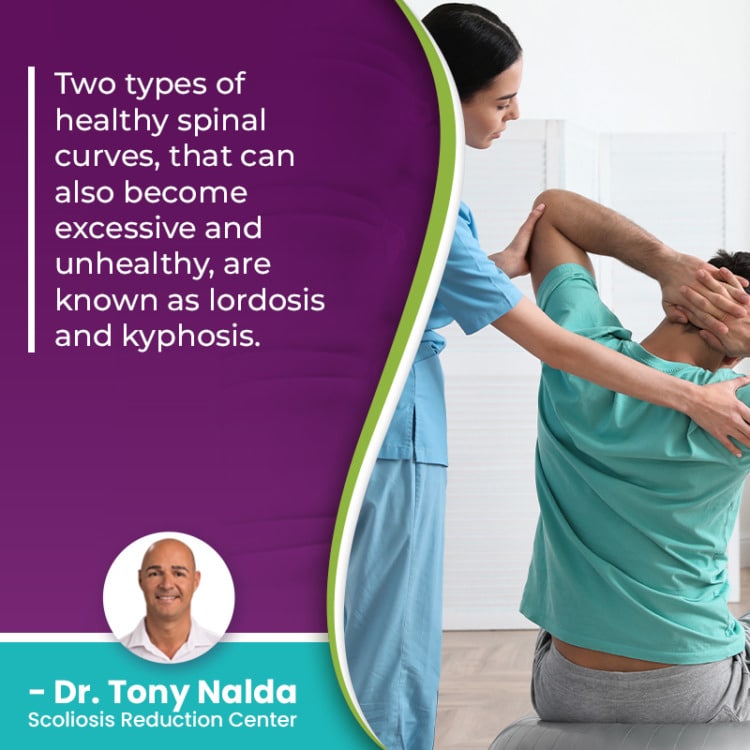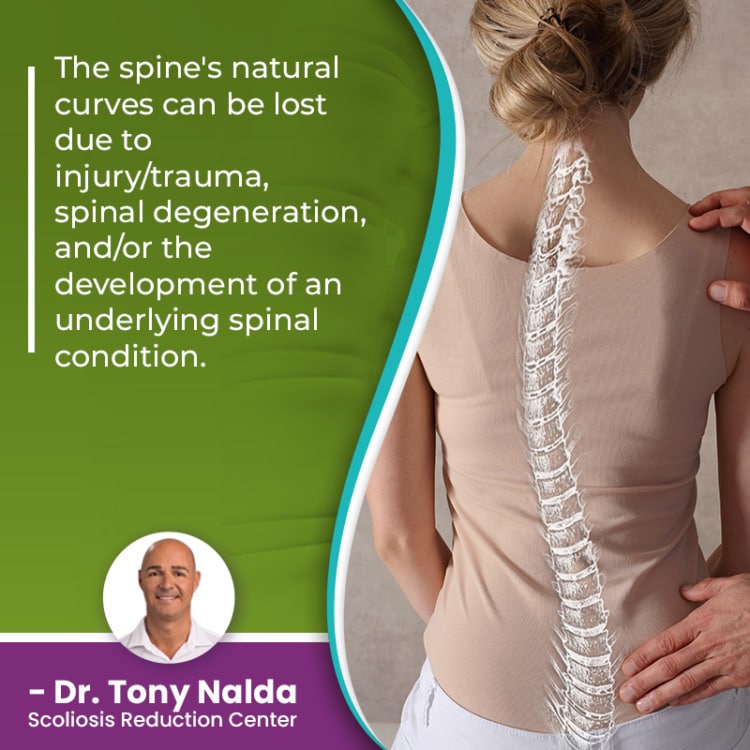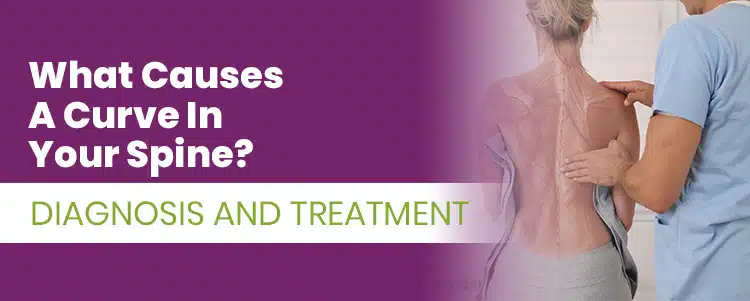The spine’s natural curvatures make it stronger, facilitate a wide range of flexible movement, and help it evenly absorb and distribute stress incurred during movement. While surgical procedures can help address unnatural spinal curves, there are also less-invasive treatment options to consider that don’t involve bone grafts and brace surgery.
There are both good and bad curves that affect spinal health and function. In order for the spine to function optimally, it needs to have its healthy curves in place, but there are a number of spinal conditions that cause a loss of its natural curves and cause the spine to become misaligned.
Let’s explore why some spinal curves are considered healthy, while others can be problematic.
Healthy Spinal Curves
A healthy spine contains natural curves at each of its three main sections: the cervical spine (neck), the thoracic spine (middle/upper back), and the lumbar spine (lower back).
If a normal spine with its curves in place is viewed from the front and/or back, it will appear straight, and when viewed from the sides, it will take on a soft ‘S’ shape.
When the spine’s healthy curves are in place, its vertebrae are aligned in a straight and neutral position as they should be, but when an unnatural spinal curve develops, one or more vertebral bodies have become excessively tilted, and this shift in position causes the spine to become misaligned.
The spine’s natural curves are key to its strength, flexibility, and ability to handle stress from impact and movement, so if a natural curve is lost, these important factors can change, and if the spine loses one of its healthy curves, the biomechanics of the entire spine are disrupted.
So healthy spinal curves help the spine function, and unhealthy spinal curves can disrupt the way it functions.

Two types of healthy spinal curves, that can also become excessive and unhealthy, are known as lordosis and kyphosis.
What is Lordosis?
Lordosis curves bend forward, towards the body’s center, in a standard ‘C’ shape, and the spine’s lordosis is found in the cervical and lumbar spinal sections.
While there is a natural range of lordosis, if a person’s degree of lordosis falls beyond a healthy normal range, the lordosis has become excessive and unhealthy.
A healthy range of cervical lordosis would fall between 20 and 40 degrees; a healthy range of lumbar lordosis would fall within 40 to 60 degrees.
So if a person’s lordosis is within those ranges, the spine’s natural lordosis falls within a healthy range so is considered a healthy spinal curve, but if a person’s lordosis becomes excessive and unnatural, this is problematic.
Excessive lordosis is most common in the lumbar spine; the lumbar spine’s vertebrae have to support the weight of the torso, spinal sections above, and feel the effects of bending, twisting, and lifting movements, and these important roles make the lower back susceptible to strain and a number of spinal conditions/issues.
If the cervical spine loses its natural lordosis, it can experience an excessive lordotic curve, or it can experience a straightening of the curve, known as military neck: named after the postural appearance of militantly standing at attention.
The health of the cervical spine is important because it has to support the weight of the neck, the head, and acts as the bridge between the brain and the rest of the body.
So hyperlordosis can cause an excessive inward spinal curvature in the cervical and/or lumbar sections.
What is Kyphosis?
Kyphosis curves bend backward, away from the body’s center, in a reverse ‘C’ shape, and the spine’s natural kyphosis is found in the thoracic spine: the largest spinal section.
The thoracic spine is vulnerable to the development of a number of spinal conditions/issues because it contains the most vertebrae (T1 to T12).
When the bones of the spine in the upper/middle back become excessively tilted and form an unnatural curve, it doesn’t just affect the single spinal section with the excessively-tilted vertebrae, but also disrupts the biomechanics of the entire spine; the spine is also known to put in compensatory curves to counteract the uneven forces of the first unnatural spinal curve.
Hyperkyphosis is also referred to as roundback because of the abnormally-rounded upper spine. A normal range of thoracic kyphosis would fall between 20 and 40 degrees, with hyperkyphosis commonly diagnosed at 40+ degrees.
So hyperlordosis and hyperkyphosis can cause a healthy spinal curve to become excessive and unhealthy, disrupting the spine’s normal function.
There are also different types of kyphosis: postural kyphosis and structural kyphosis. Structural kyphosis is far more complex to treat because it involves a structural abnormality within the spine itself, and postural kyphosis is caused by chronic poor posture, so a change in body position can alter the curve, and generally, physical therapy and lifestyle guidance is enough to address a spine curvature disorder caused by just poor posture.
There is also congenital kyphosis that tends to be more severe because it’s caused by a birth defect, and treatment can involve congenital kyphosis exercises.
There are many conditions that cause a loss of the spine’s healthy curves; scoliosis is one of them.
How Scoliosis Changes Spinal Curves

The spine’s natural curves can be lost due to injury/trauma, spinal degeneration, and/or the development of an underlying spinal condition.
Scoliosis is a highly-prevalent spinal curvature disorder that involves the development of an unnatural sideways curve that also rotates, making it a complex 3-dimensional condition.
So a condition like scoliosis causes a loss of healthy spinal curves, and their replacement with unhealthy ones.
Scoliosis ranges in severity from mild to moderate and severe to very severe, and as a progressive condition, scoliosis curves are virtually guaranteed to increase in size over time, increasing the amount of uneven forces exposed to the spine, the spine’s surrounding muscles and nerves, and the entire body.
As scoliosis progresses, it’s getting more complex to treat, and its effects tend to also get more noticeable.
So what are the effects of unnatural spinal curves on the body?
Scoliosis Effects
Scoliosis effects are highly variable; what one patient experiences isn’t always indicative of what others will face, and as a progressive condition, where a patient’s scoliosis is at the time of diagnosis doesn’t mean that’s where it will stay.
Scoliosis affects all ages but is most commonly diagnosed in adolescents between the ages of 10 and 18, and as growth triggers progression, this age group is the most at risk for rapid-phase progression, and in severe cases, and particularly those that are left untreated, complications can develop.
So when we’re talking about children, the main condition effect is postural deviation:
- Uneven shoulders
- Uneven shoulder blades
- The development of a rib arch (body hump)
- Uneven waist line
- Uneven hips (hip leaning prominently or one hip sitting higher than the other)
- Arms and legs that appear to hang at different lengths
Additional effects can include disruptions to gait, balance, and coordination, and while there are no treatment guarantees, early detection and treatment is associated with better treatment results, and while a slight curve can be difficult to diagnose, knowing the early signs to watch for can help.
When it comes to scoliosis in adults, the main effect is pain: back pain and/or pain that radiates into the extremities, and scoliosis diagnosed in older adults is often degenerative scoliosis, caused by natural age-related spinal degeneration and the cumulative effect of certain lifestyle choices.
Spine curvature disorders treated proactively tend to be more responsive; as scoliosis progresses, the spine becomes increasingly rigid and less responsive to treatment.
Severe spine curves can cause additional complications involving digestive issues, lung impairment, and neurological symptoms.
There are also different types of scoliosis a person can develop including idiopathic scoliosis, neuromuscular scoliosis, degenerative scoliosis, and congenital scoliosis.
Neuromuscular scoliosis is caused by the presence of a larger neuromuscular condition such as cerebral palsy, muscular dystrophy, and spina bifida.
Degenerative scoliosis is caused by spinal degeneration, and congenital scoliosis is caused by spinal malformations that occur as the spine develops in utero; this commonly involves abnormal vertebrae development.
Scoliosis, and most unnatural spinal curves, are diagnosed through a combined physical exam that includes taking family history and an Adam’s forward bend test as bending forward makes the spine highly visible, along with any related trunk asymmetries.
Conclusion
Natural curves in the spine are just that: natural and healthy.
When a spinal curve becomes unnatural, it doesn’t just affect the spine, but also its surrounding muscles and nerves; muscle weakness and muscle imbalances are common as the core muscles are pulled in different directions by the unnatural spinal curve.
When an unnatural structural spinal curvature disorder develops, there are two main treatment options for patients to choose between: surgical treatment or non-surgical treatment.
While spinal fusion can help straighten a bent spine, it’s a costly, invasive, and risky procedure, and many cases of scoliosis, and other spinal conditions, can be treated successfully without surgery.
When an unhealthy spinal curvature of the spine develops, in order to maintain normal function, its underlying cause, when known, has to be the focus of treatment, and while medication can help with pain relief, these are only short-term solutions, and when it comes to long-term sustainable treatment results, structural spinal conditions need to be impacted on a structural level.
Here at the Scoliosis Reduction Center®, my hyperlordosis, hyperkyphosis, and scoliosis patients benefit from a proactive conservative treatment response that minimizes symptoms by working towards preventing progression, rather than attempting to reverse conditions effects once they’re established.
An abnormal curve in the spine isn’t always going to cause noticeable effects, but when it does, it’s important to pay attention because if progressive, a mild spinal curvature can easily progress to become a moderate and/or severe spinal curvature.
If left untreated, spinal conditions can cause health problems and affect body movement and quality of life, so don’t hesitate to reach out for guidance and support.




